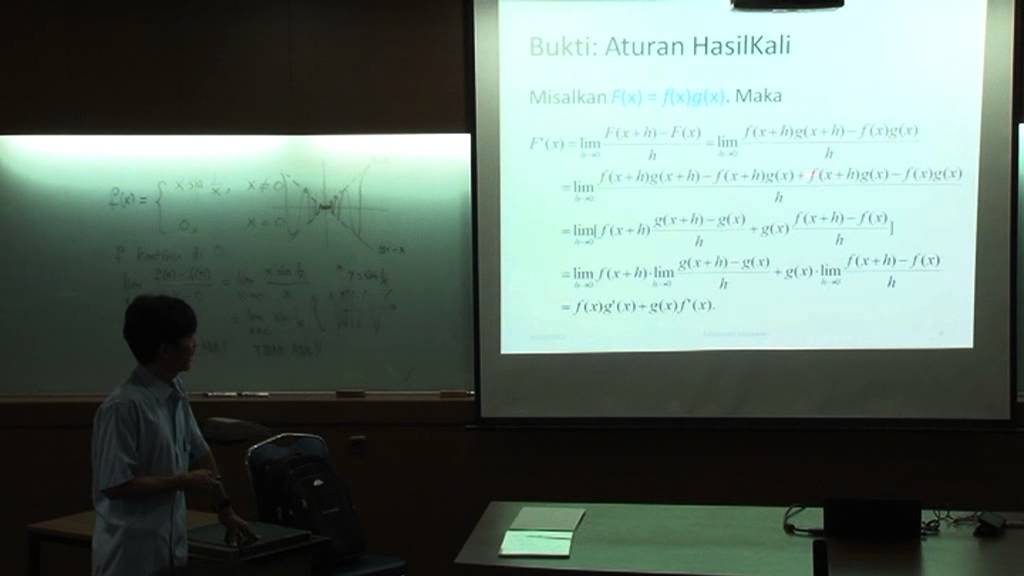📚 REGRAS DE DERIVAÇÃO - Cálculo 1 (#18)
Summary
TLDRIn this video, Professor Paulo Pereira provides an in-depth explanation of key calculus concepts, focusing on derivative rules. He covers essential topics like the derivative of constant functions, power rule, product rule, quotient rule, and how to apply them to different functions. Through practical examples, he explains the step-by-step process of finding derivatives, including common functions like polynomials and rational functions. The video also includes a demonstration on finding tangent lines and calculating derivatives at specific points, helping viewers understand the practical application of calculus concepts in problem-solving.
Takeaways
- 😀 The derivative of a constant function is always zero.
- 😀 The power rule states that to differentiate a term like x^n, multiply by the exponent and subtract one from the exponent.
- 😀 For simple functions, applying the power rule makes differentiation faster and more efficient than using the limit definition.
- 😀 The product rule allows you to differentiate a product of two functions: f(x) * g(x). The derivative is f'(x) * g(x) + f(x) * g'(x).
- 😀 For a quotient of two functions, use the quotient rule: (f/g)' = (f' * g - f * g') / g².
- 😀 The derivative of x is 1, and the derivative of a constant is 0.
- 😀 When differentiating a function like a polynomial, apply the power rule to each term individually.
- 😀 The derivative of x raised to any power (like x^n) follows the pattern: multiply by the exponent and reduce the exponent by 1.
- 😀 The chain rule and product rule can simplify complicated differentiation tasks, especially with composite functions.
- 😀 The tangent line at a point on a function can be found by using the derivative to determine the slope at that point, then using the point-slope form of a line.
Q & A
What is the derivative of a constant function?
-The derivative of a constant function is always zero. This is because a constant function has no change, and the derivative measures the rate of change.
How do you differentiate a function raised to a power (like x^n)?
-To differentiate a function of the form x^n, multiply by the exponent and then subtract one from the exponent. For example, the derivative of x^3 is 3x^2.
What happens when you differentiate a term like x?
-The derivative of x is 1. This is because the exponent of x is 1, and applying the power rule gives 1 * x^(1-1), which simplifies to 1.
How do you differentiate a product of two functions?
-To differentiate a product of two functions f(x) and g(x), use the product rule: (f * g)' = f' * g + f * g'. This means you take the derivative of the first function and multiply it by the second, then add the first function multiplied by the derivative of the second.
What is the quotient rule for differentiation?
-The quotient rule is used when differentiating a division of two functions, f(x)/g(x). The rule is: (f/g)' = (f' * g - f * g') / g^2. This means you differentiate the numerator, multiply it by the denominator, subtract the numerator multiplied by the derivative of the denominator, and then divide by the square of the denominator.
What does the notation f'(x) represent?
-The notation f'(x) represents the derivative of the function f(x) with respect to x. It tells you the rate of change of f(x) at any point x.
What is the derivative of a function of the form x raised to a negative power (e.g., x^-n)?
-The derivative of x raised to a negative power is obtained using the power rule. For example, the derivative of x^-2 is -2x^-3. This is because you multiply by the exponent and then subtract 1 from the exponent.
How do you find the equation of the tangent line to a function at a given point?
-To find the equation of the tangent line, first calculate the derivative of the function (the slope of the tangent). Then, use the point on the curve where the tangent touches, and apply the point-slope formula: y - y0 = m(x - x0), where m is the derivative at that point.
What happens when you differentiate a term like 3x^2?
-To differentiate 3x^2, you apply the power rule: multiply the exponent by the coefficient (2 * 3 = 6), and then subtract 1 from the exponent. The result is 6x.
What is the significance of the constant when differentiating a function?
-When differentiating a function that has a constant multiplied by a variable term, you keep the constant and differentiate the variable term normally. For example, the derivative of 3x^2 is 6x, where 3 is the constant multiplied by the derivative of x^2.
Outlines

This section is available to paid users only. Please upgrade to access this part.
Upgrade NowMindmap

This section is available to paid users only. Please upgrade to access this part.
Upgrade NowKeywords

This section is available to paid users only. Please upgrade to access this part.
Upgrade NowHighlights

This section is available to paid users only. Please upgrade to access this part.
Upgrade NowTranscripts

This section is available to paid users only. Please upgrade to access this part.
Upgrade NowBrowse More Related Video
5.0 / 5 (0 votes)





